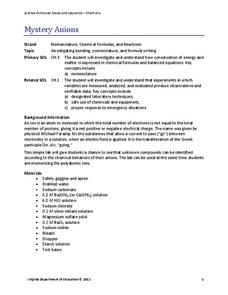Virginia Department of Education
States of Matter
Scientists have been studying exothermic reactions before they were cool. The lesson begins with a discussion and a demonstration of heat curves. Scholars then determine the heat of fusion of ice and the heat needed to...
Virginia Department of Education
Mystery Anions
Lost an electron? You should keep an ion them. Young chemists learn qualitative analysis in the second lesson of an 11-part chemistry series. After observing reactions of simple salts, the teacher provides pupils with unknown...
Pingry School
Comparing Activities of Selected Metals
Don't overreact! A simple experiment demonstrates chemical reactions as scholars mix chemical solutions and metals in a large well plate. They note all changes to the metals, solutions, precipitate, colors, and more. A full data table...
Project Maths
The Unit Circle
It's not just any circle—it's the unit circle. The fourth instructional activity in the series is an introduction to the famous unit circle. While working through a series of activities, young scholars learn the components of the unit...
Curated OER
Writing Half Reactions
In this half reactions activity, students read about redox reactions and learn how to write half reactions showing the oxidized part of the reaction and the reduced part of the reaction. Students are given 10 redox reactions and they...
Curated OER
Six Types of Reactions
In this types of chemical reactions worksheet, high schoolers fill in 5 blanks with the proper type of chemical reaction described in the sentence. Students balance 5 equations and identify the type of chemical reaction for each equation.
Curated OER
Predicting the Products of a Reaction
In this reactions worksheet, students predict the products of 5 equations and write the equations for 5 reactions using their knowledge of types of reactions.
Curated OER
Balancing Equations Online
In this balancing equations worksheet, students use an on line source to answer questions about balanced equations and they write balanced equations for various types of reactions. They balance equations using an on line game that allows...
Curated OER
Balancing Equations and Identifying Reaction Types
In this balancing equations worksheet, students balance twelve equations by placing the proper coefficients in front of reactants and products and they identify the type of reaction each equation represents.
Curated OER
Writing and Balancing Equations
In this equations worksheet, students identify simple reactions as direct combination, decomposition, single replacement, or double replacement. This worksheet has 20 fill in the blank questions.
Curated OER
Writing Nuclear Reactions
In this writing nuclear reactions worksheet, students read about nuclear equations for alpha decay, beta decay and positron emission. They are given the rules for writing nuclear reactions and a sample problem.
Curated OER
Types of Reactions
In this types of reactions worksheet, students balance 5 chemical equations and identify the type of reaction. They read 3 scenarios and identify the type of reaction going on in each situation.
Curated OER
Classifying Chemical Reactions
In this chemical reactions worksheet, students learn about the 5 types of chemical reactions as well as endothermic and exothermic reactions. Students are given 5 equations to balance and they identify the type of reaction for each...
Curated OER
Reactions in Aqueous Solutions
In this solutions worksheet, students calculate the molarity and solubility for given reactions. Students work on dilution, precipitation, and titration reactions. This worksheet has 15 problems to solve.
Curated OER
Neutralization Reactions
In this neutralization reaction worksheet, students read about how neutralization reactions are double replacement reactions in water. They complete five questions about neutralization reactions including completing five reactions and...
Curated OER
Types of Chemical Reactions Lab
In this chemical reactions worksheet, students experiment with several different reactions and identify each as a single replacement, double replacement, synthesis, decomposition or combustion reaction. Students observe the changes in...
Curated OER
Analyzing Oxidation-Reduction Reactions
In this oxidation-reduction reactions worksheet, students read about reactions where elements gain and lose electrons. When elements gain electrons they are reduced and when the lose electrons the elements are oxidized. They are given...
Curated OER
Identifying Reaction Types
For this reactions worksheet, students are given nine chemical reactions to identify as single replacement, double replacement, synthesis or decomposition reactions.
Curated OER
WS 4.7 Writing Chemical Reactions
In this chemical reactions worksheet, students are given fourteen chemical reactions that they must write using chemical formulas for the reactants and products. They balance each equation by placing the proper coefficients in front of...
Curated OER
Limestone Reactions
In this limestone reactions worksheet, students read about the various types of limestone reactions and complete a diagram of deposits in a cave. They answer two questions about limestone reactions.
Curated OER
The "Laws" and Principles of Chemical Reactions
In this chemical reaction principles worksheet, students read about definite proportions and the law of conservation of mass. Students read about how to balance a chemical equation. Then students complete 20 fill in the blank, 2 short...
Curated OER
Balancing Equations
In this balancing equations worksheet, students balance ten equations by placing the proper coefficients in front of reactants and products to balance the number of atoms.
Curated OER
Balancing Chemical Equations
In this balancing chemical reactions worksheet, high schoolers fill in the proper coefficients in front of the reactants and products of 20 equations to balance each given chemical equation.
Curated OER
WS 10.8 Acid-Base Neutralization and Titration
In this acid and base worksheet, students write balanced equations for neutralization reactions, they calculate volumes of acids and bases needed to titrate solutions and they determine molarities of solutions.























